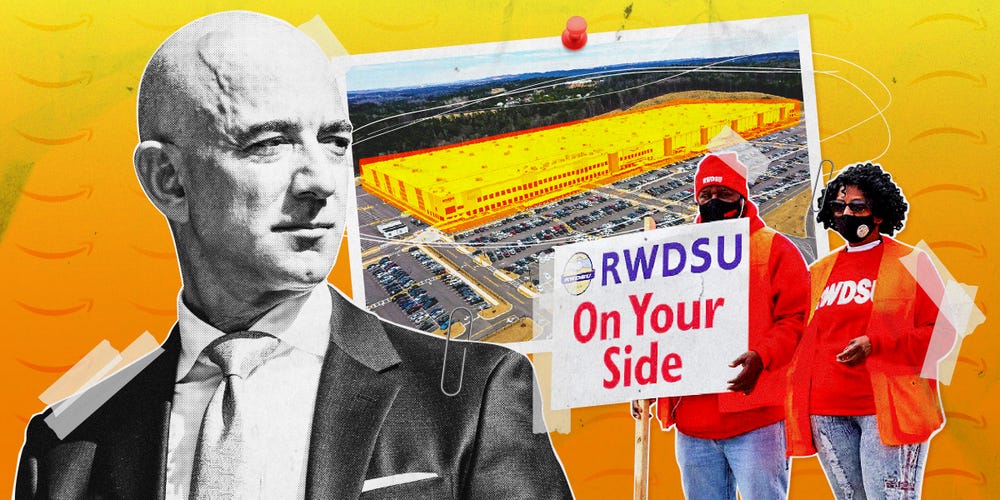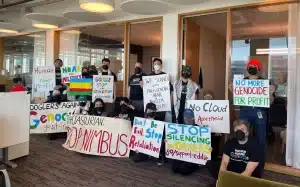The union drive in the Amazon warehouse in Bessemer, Alabama was defeated, yet the fight goes on, both in the long term and in the short term, and the union organizers are currently contesting the results. It is important for the Left and the labor movement to analyze these results in order to understand why the drive was unsuccessful and how similar outcomes can be avoided in the future. To that end, Left Voice is publishing our own articles analyzing the results while also inviting others to contribute to the discussion. Below is one such contribution from labor historian Michael Goldfield, author of The Southern Key. If you would like to send your thoughts, please contact us at [email protected]. This article, like our other guest posts, does not necessarily reflect the opinions of Left Voice.
First, we must recognize that the overwhelming vote against the union in Bessemer marks a decisive defeat, not to be underestimated. It will undoubtedly have a dampening effect on other workers, especially given its broad media attention and the high expectations of many.
Also, we need to recognize that this is a difficult period to organize for unions:
- There is the pandemic and widespread unemployment, with the recognition that there are many other workers who are potential replacements
- Threats by big companies, especially Amazon, that they might just move a facility if it were unionized
- The vicious, overwhelming nature of anti-union campaigns by management, well-documented here.
- The low level of unionization at present, especially in the private sector, below 6% nationally now
- The low level of confidence in general that a union would be able or willing to do much
The logistics industry, however, is doing well, especially during the pandemic. It is central, not just to retail (as with Amazon and Walmart), but also more importantly to global, just in time, manufacturing. So, it is an important arena where workers, if they organize on a broad scale, could potentially have a great deal of leverage, what I call structural power. The industry includes not just warehouse workers, but truck drivers, air, railroad, shipping, and port workers (who tend to be more unionized), all of whom are pivotal to moving goods.
Left Voice is hosting a panel with a Bessemer Amazon worker and Robin D.G. Kelly, author of Hammer and Hoe to discuss Black struggle, labor struggle and the results of the Amazon unionization vote. Sign up here. RSVP to the Facebook event here.
Given all this, it is important to look at the union’s strategy, comparing it to both other failed campaigns (especially of the UAW in Mississippi, Chattanooga, and Kentucky), but also to a variety of mostly less-publicized campaigns that were in fact successful.
It is hard to know how well the union did or did not organize workers inside the facility. What we do know is that they had only a few workers as visible spokespeople. They seemed to rely on using other unionists to leaflet and talk to workers going in and out of the facility and bringing in high profile people (including Sanders) to speak to supporters. While not as sclerotic as the various UAW campaigns, this was clearly not enough.
Also, the recipes that give a union a greater chance of success are not necessarily that radical.
Three successful campaigns are worth noting. Two are little-known. The UAW, of course, failed abysmally at the Toyota TMMK plant, yet construction unions in Kentucky were overwhelmingly successful. Toyota originally tried to hire non-union construction labor to build the plant and to do maintenance once the plant was built. The unions defeated these proposals and gained all union workers in both instances. They mobilized thousands of construction workers to demonstrate, including disrupting Toyota events and exposing some of their detrimental practices. They formed alliances with construction unions in nearby states, who nationally refused to aid Toyota and agreed to aid them. The comparison to the UAW is documented in a wonderful dissertation by my former student Amy Bromsen.
West Virginia and other teachers mobilized their constituencies in massive demonstrations. In Oklahoma, thousands of teachers occupied the state house. The RWDSU held no mass rallies outside the facility involving the Amazon workers themselves. These rallies might have emboldened activists and more reticent workers and would have taken place outside the company’s control. As far as I know, they did not rent facilities in Bessemer or Birmingham for workers to hold large meetings. These were also problems with the UAW approaches. So, their mobilization tactics were not adequate.
While I have no objection to the support of political figures or entertainers, they did not do a good job of mobilizing their most important allies, what I call associative power. They should have put pressure on largely Black politicians in Bessemer and Birmingham to come out in support. The successful organizing of catfish farm workers in Mississippi, for example, emerged as civil rights struggles, mobilizing community members and forcing political leaders to actively support them. Their appeal to BLM sympathies, in contrast, seemed somewhat wooden. Contrary to media reports, Alabama is not that unorganized compared to other states in the South. With a bit under 10% unionization, compared to 1 or 2% in North Carolina and South Carolina, they have many potential allies. They could have set up picket lines outside the facility and encouraged unionized miners, food processing workers (which they did a tiny bit), and others to join them.
And, there were not clear sets of public demands the union put forward, just dignity, etc. They should have said, if the union is certified, we will ask for $20 or so per hour, union safety and health committees, longer and more frequent breaks and lunch periods, less monitoring by computers and supervisors, no discussion of output and breaks without a union steward present, etc., demands that could have been developed at public meetings of workers, not to put in stone the examples that I have given.
The question of control of the workplace, pace of work, monitoring, etc. is ubiquitous across industries, something that needs to be formulated precisely for each type of work. In manufacturing, both time study and monitoring have over many decades become much more sophisticated and invasive. The healthcare system has become much more regulated. A bit of this is good, computerized checking to make sure the right patient is getting the right medicine, the correct body part is being operated on, etc. But, the overall view that whether a procedure should be allowed by an insurance company, or even whether an emergency room patient should be admitted, ought to often be decided upon by a non-medical person, or that doctors ought to be on time study (7 minutes for this type of examination, etc.) is outrageous. In many cases, these types of intrusions have even led doctors at certain places to attempt to unionize. This control is far more intense in Amazon facilitation centers and needs to be addressed sharply.
Finally, while it is necessary to organize extensively inside the facility, even at times on a non-majority basis, this is not a permanent solution. Large companies can only be forced to bargain extensively, especially over wages and benefits, but general safety conditions as well, when the whole company is organized into a union. This increases workers’ leverage in a way syndicalist approaches do not. In more stable industries, even the IWW, e.g., among Philadelphia longshoremen, was forced to take this approach. And, we might note that unionized coal miners have a leverage that they would not have if they were not unionized. So, I have little sympathy for the syndicalist arguments, aside from their emphasis on workplace organizing and mobilization.










